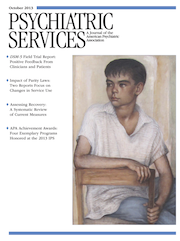To the Editor: Depression is an important public health problem with significant costs both to individuals and society. In 2003, the U.S. lifetime prevalence of major depressive disorder was 16.2% (
1). Depression is the leading cause of disability (
2), with an estimated cost of $83.1 billion in the United States in 2000 (
3). As of 2009, the U.S. Preventive Services Task Force (USPSTF) recommends “screening adults for depression in clinical practices that have systems in place to assure accurate diagnosis, effective treatment, and follow-up” (
4). In light of these recommendations, the primary aim of the study reported here was to estimate the rate of depression screening in the U.S. outpatient office setting.
The National Ambulatory Medical Care Survey (NAMCS) is an annual cross-sectional survey of visits to office-based physicians across the United States, stratified by physician specialty (
5). Approximately two of three sampled physicians participate in the survey. Depression screening at sampled visits is ascertained and recorded by the responding physician, a member of his or her staff, or a U.S. Census Bureau field representative who reviews medical records for documentation of the screening performed. Because information on depression screening was first collected in 2005, data from 2005 to 2010 were analyzed. The USPSTF does not support screening for children 11 years and younger. Therefore, only visits for patients 12 years and older were included. Visits to psychiatrists were excluded from the analysis.
SAS version 9.2 was used to analyze the data; SAS SVY PROCS was used to account for the complex survey design. Sampled visit weights were applied, which produced unbiased national estimates. The percentage of visits, overall and with primary care physicians (general and family practitioners, internists, pediatricians, and obstetricians-gynecologists), linked with depression screenings are reported with 95% confidence intervals (CIs).
Over the period, the average number of annual visits was estimated to be 947 million, and the average annual frequency of documented depression screening was 1.3% (CI=1.1%–1.5%). For visits to primary care physicians, the rate was 1.8% (CI=1.5%–2.1%). Screening was most common among internists (2.8%, CI=1.8%–3.8%), followed by gynecologists (2.4%, CI=1.3%–3.4%), family physicians (1.9%, CI=1.6%–2.2%), pediatricians (1.8%, CI=1.0%–2.6%), and other specialists (.5%, CI=.2%–.7%). Among visits for which no screening was documented, 7.7% (CI=7.2%–8.2%) were for patients who already had a diagnosis of depression.
The NAMCS has several limitations. It does not record whether sampled offices have adequate staff for screening and follow-up care. To our knowledge, the accuracy of NAMCS methods for identifying depression screening through chart review has not been confirmed. Because visits were the unit of analysis and physicians may screen patients only annually, the period prevalence of screening for patients over a year cannot be estimated.
Ultimately, depression screening rates are quite low and further steps are required for improvement. Depression screening itself can be as simple as asking two questions. Thus it is likely that screening may not be performed because the necessary follow-up care resources are not available at some offices. It is therefore important to develop a plan that improves access to depression management resources for outpatient offices.
Acknowledgments and disclosures
The Center for Dermatology Research is supported by an unrestricted educational grant from Galderma Laboratories, L.P. The authors thank Steven R. Feldman, M.D., Ph.D., Scott A. Davis, M.A., and Cheryl J. Gustafson, M.D., for constructive suggestions and direction for this research.
The authors report no competing interests.

